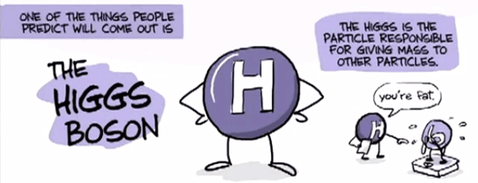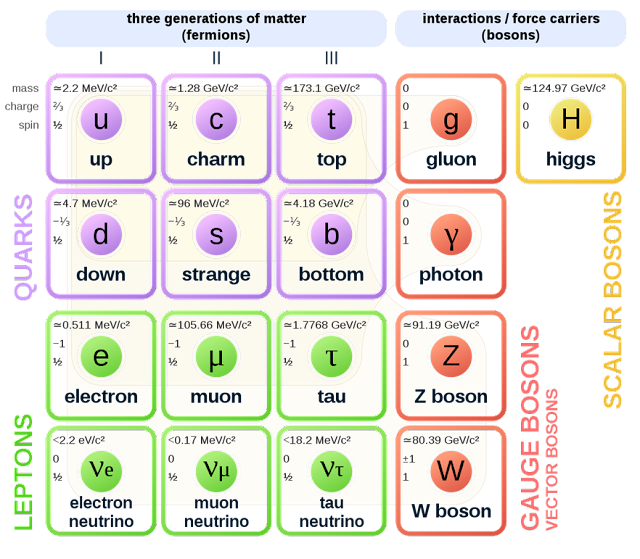 Graham writes … For those of you who are into this kind of thing, there have been rumours in the scientific press recently that new physics is afoot. So, what’s it all about, and should we be excited? I know I will be … But before we talk about the latest developments … the last time that there was a significant engagement between the physics community and the popular press was in 2012, when the discovery of the Higgs boson was confirmed. Looking back on it, it was quite an exciting time. Interest, and confusion, was whipped up by the adoption of an unusual nickname for this elusive sub-atomic particle – the ‘God particle’! This was principally the reason for the media interest, and this unlikely title was first coined by Physics Nobel Laureate Leon Lederman in 1994. He told people that he invented the name because the Higgs boson – then a purely theoretical entity – was ‘so central to the state of physics today, so crucial to our understanding of the structure of matter, yet so elusive’ (1). As it turned out, this rather confusing association of the particle with God turned out to be not such a bad thing, as it got people talking about frontier research in particle physics. I recall a time in the 1960s/1970s when particle physics was in a state of confusion, with the discovery of a plethora of new particles, but without any understanding of the underlying structure of how they fitted together. Over time, as mentioned in Chapter 2 of the book (2), the physicists have developed a ‘Standard Model of Particle Physics’ that hopefully makes sense of it all. This has been a great success, and has allowed a greater understanding of the quantum world. The diagram below shows the current status of the standard model, indicating all the particles that are believed to be fundamental (each of the particles also have a corresponding antiparticle, which are not shown). In other words, the particles listed are considered to be indivisible. For example, the ‘familiar’ particles that make up the nucleus of an atom – the proton and the neutron – are now known to be divisible. These particles are composed of 3 quarks, (the family of quarks is shown in purple). In this case, the proton is made up of 2 ‘up’ quarks and one ‘down’ quark, and the neutron 2 downs and one up. There are six ‘flavours’ of quark in all. Shown in green, there are six types of particle referred to as leptons – after the Greek leptos, meaning ‘lightweight’ – which are also considered to be fundamental. The most ‘familiar’ of these is the electron. However, this has larger counterparts – the muon and the tauon, which are about 200 times and 3,500 times heavier than the electron, respectively. Associated with each of these, there is a neutrino particle. Remarkably, physicists have not yet been able to measure the fundamental attributes of the neutrinos (such as mass!) because their interaction with matter is so extremely weak. For example, they can pass through our home planet without leaving any tell-tale sign of their presence. All that is known is that the three types of neutrino have a combined mass that is several million times less than that of an electron, but there is sufficient understanding of neutrino behaviour to appreciate that they are not massless.  The red particles are called bosons and have the property of being ‘force carriers’, and have the job of exercising the forces between particles. For example, the electromagnetic (EM) force acts upon charged particles by the exchange of a photon. A similar mechanism is envisaged for the gluon which governs the strong nuclear force, and the W and Z bosons which administer the weak nuclear force.  However, I am aware that our understanding of the quantum world remains incomplete. For example, it is worth remarking upon the significant absence of a boson (‘force carrier’) for the gravitational force (in its absence, it has nevertheless been given the name ‘graviton’). As discussed in the book (3) gravity has evaded all attempts to include it in the standard model. Indeed, there is debate as to whether gravity is a force in the same sense as the other three fundamental forces (EM, weak nuclear and strong nuclear), and this is probably an obstacle to achieving the unification. As described in the book (4), the mechanism through which Einstein’s gravity acts is completely different to those of the other forces. Briefly, a mass (for example, a star) produces a curvature in the surrounding space-time, and objects moving in the star’s neighbourhood move along trajectories that take the shortest distance in the curved geometry. So, it could be summarised by saying that mass shows space how to curve and curved space shows mass how to move. Inherently Einstein’s gravity is a classical theory, involving ‘geodesics in a curved Riemannian geometry’ (this phrase may be meaningful to some readers?), so it is not too surprising that the quest for unification with the other ‘quantised forces’ is proving to be very challenging. It is a problem of attempting to unify an inherently classical theory with its quantum counterparts.  Another rather large hole in the standard model is the notion that so-called ‘normal matter’, as described by the current standard model, comprises only about 5% of the total matter/energy content of the Universe. The other 95% is comprised of dark matter and dark energy (5), and currently we have no idea what these are. So, there is probably a whole new family of particles waiting to be added to the standard model to describe this so-called ‘dark universe’. We know our theories are incomplete, and there is plenty of new physics waiting for a team of new ‘Einsteins’ to show us the way.  However, coming back to the things we think we understand about the standard model, we finally come to the Higgs boson, identified in yellow and sitting all by itself on the right-hand side of the diagram. So, what is the Higgs boson, and what does it do? It all started with some published theoretical work by Peter Higgs in 1964, which first predicted the existence of the particle. It took a remarkable 48 years for the experimental community to catch up with the theoreticians, with the development of the Large Hadron Collider facility at CERN (Conseil Européen pour la Recherche Nucléaire) near Geneva. This remarkable machine produces sufficient energy to allow the creation and detection of this new particle, for which Peter Higgs, now a retired professor at the University of Edinburgh, UK, received the Nobel Prize in Physics in 2013. In order for such a breakthrough to be declared officially as a discovery, it has to be confirmed at the ‘5-sigma level’. A 5-sigma result is considered to be the gold standard for significance, which is just a bit of statistics jargon which translates into a tiny probability (1 chance in about 3.5 million) that the event is a random fluke. The remarkable property of the Higgs boson is that it gives all the other particles in the standard model the attribute of mass, with the accompanying property of inertia. The Higgs boson has an associated field which has a non-zero value throughout all of space, which is sometimes referred to as the Higgs ocean. As particles traverse this field, they interact with it in proportion to their mass – in other words, each fundamental particle acquires its specific mass. Of course, some particles such as photons of light are massless, because they do not interact with the Higgs field at all. More recently, physicists have continued to uncover further anomalies that point to new particles that comprise quantum reality. I hope you will join me again when I say something more about this intriguing idea in Part 2 of ‘New Physics?’. Graham Swinerd Southampton October 2021 (1) Alister McGrath, Inventing the Universe, Hodder & Stoughton, p. 57. (2) Graham Swinerd & John Bryant, From the Big Bang to Biology: where is God?, KDP publishing, 2020. (3) Ibid., chapter 2, pp. 36-38. (4) Ibid., chapter 3, pp. 52-56. (5) Ibid., chapter 3, pp. 74-76.
0 Comments
|
AuthorsJohn Bryant and Graham Swinerd comment on biology, physics and faith. Archives
July 2024
Categories |


 RSS Feed
RSS Feed
